Marketing Solar Solutions: Consumer Insight Report for Australia
VerifiedAdded on 2023/06/11
|8
|2571
|199
Report
AI Summary
This report analyzes the potential of solar energy in meeting energy consumption challenges, particularly in the Australian household market struggling with increasing power bills. It reviews existing literature on solar energy adoption and proposes three marketing strategies grounded in the self-determination theory. The first strategy emphasizes educating customers about cost savings through targeted advertising. The second focuses on in-depth industry knowledge to highlight product competence and differentiate from competitors. The third advocates for strategic partnerships to build trust and expand market reach. The report concludes with a recommendation for marketers to leverage the growing demand for solar energy by implementing these strategies and continuously innovating to enhance their market potential. Desklib provides access to similar solved assignments and resources for students.
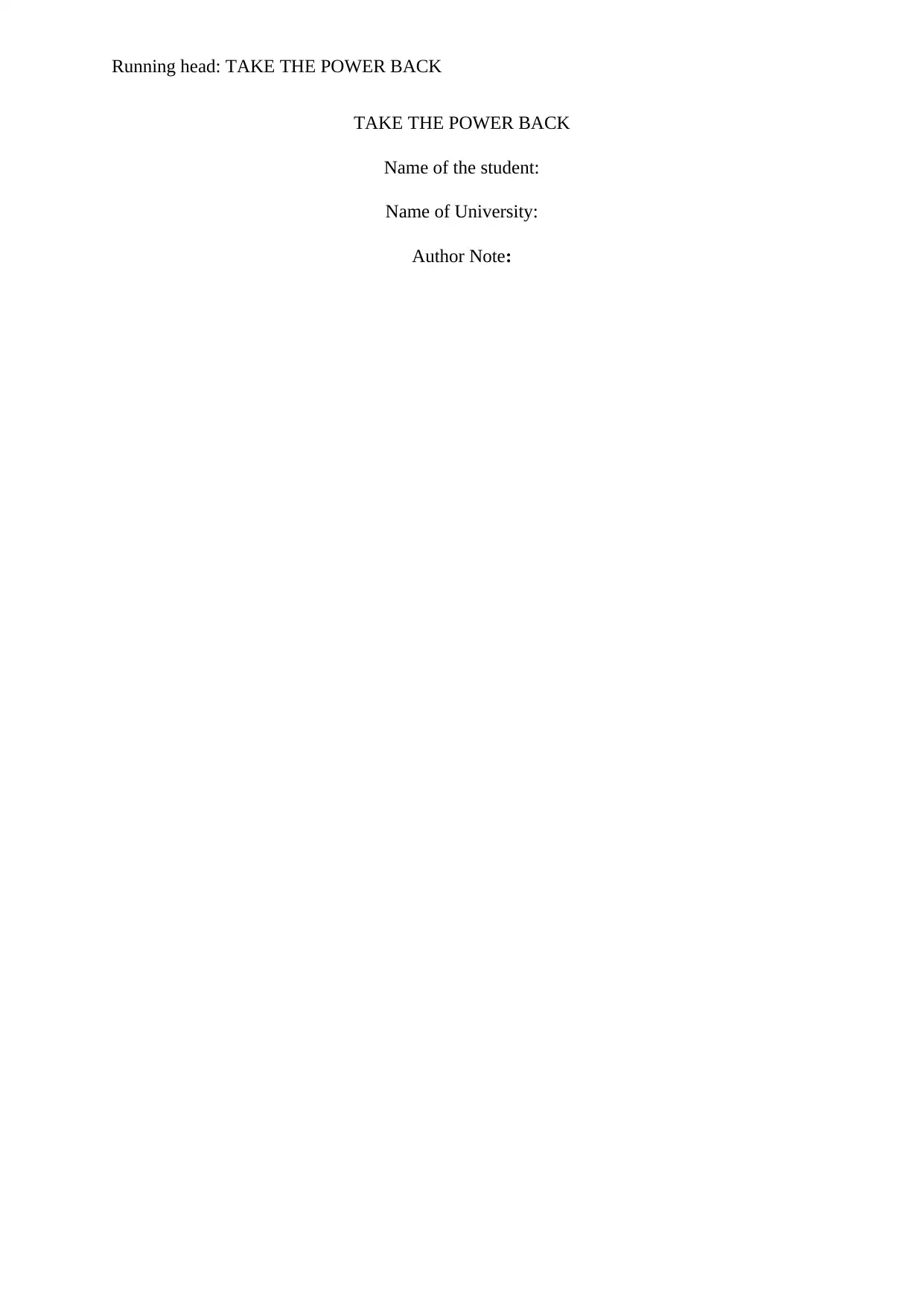
Running head: TAKE THE POWER BACK
TAKE THE POWER BACK
Name of the student:
Name of University:
Author Note:
TAKE THE POWER BACK
Name of the student:
Name of University:
Author Note:
Paraphrase This Document
Need a fresh take? Get an instant paraphrase of this document with our AI Paraphraser
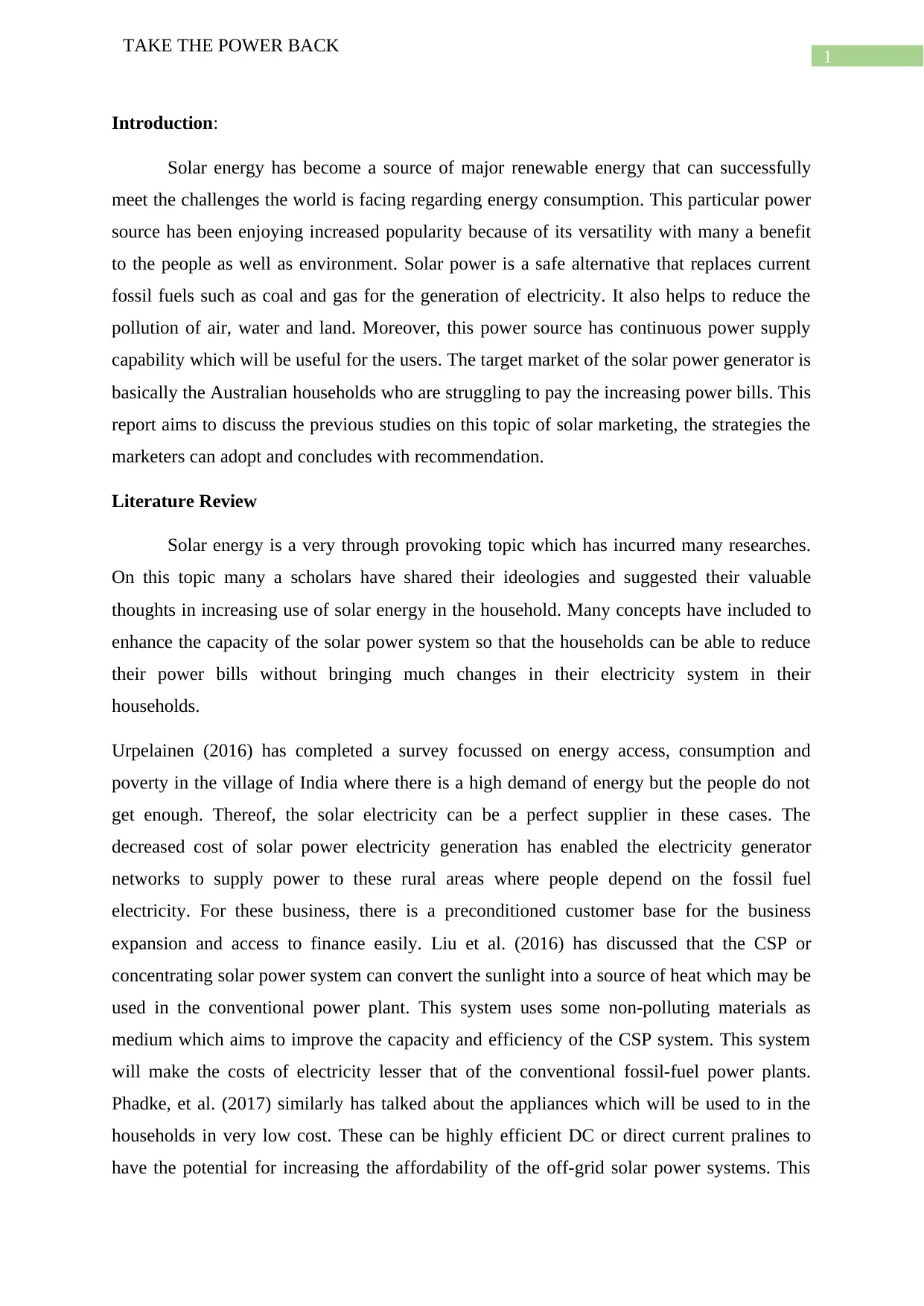
1
TAKE THE POWER BACK
Introduction:
Solar energy has become a source of major renewable energy that can successfully
meet the challenges the world is facing regarding energy consumption. This particular power
source has been enjoying increased popularity because of its versatility with many a benefit
to the people as well as environment. Solar power is a safe alternative that replaces current
fossil fuels such as coal and gas for the generation of electricity. It also helps to reduce the
pollution of air, water and land. Moreover, this power source has continuous power supply
capability which will be useful for the users. The target market of the solar power generator is
basically the Australian households who are struggling to pay the increasing power bills. This
report aims to discuss the previous studies on this topic of solar marketing, the strategies the
marketers can adopt and concludes with recommendation.
Literature Review
Solar energy is a very through provoking topic which has incurred many researches.
On this topic many a scholars have shared their ideologies and suggested their valuable
thoughts in increasing use of solar energy in the household. Many concepts have included to
enhance the capacity of the solar power system so that the households can be able to reduce
their power bills without bringing much changes in their electricity system in their
households.
Urpelainen (2016) has completed a survey focussed on energy access, consumption and
poverty in the village of India where there is a high demand of energy but the people do not
get enough. Thereof, the solar electricity can be a perfect supplier in these cases. The
decreased cost of solar power electricity generation has enabled the electricity generator
networks to supply power to these rural areas where people depend on the fossil fuel
electricity. For these business, there is a preconditioned customer base for the business
expansion and access to finance easily. Liu et al. (2016) has discussed that the CSP or
concentrating solar power system can convert the sunlight into a source of heat which may be
used in the conventional power plant. This system uses some non-polluting materials as
medium which aims to improve the capacity and efficiency of the CSP system. This system
will make the costs of electricity lesser that of the conventional fossil-fuel power plants.
Phadke, et al. (2017) similarly has talked about the appliances which will be used to in the
households in very low cost. These can be highly efficient DC or direct current pralines to
have the potential for increasing the affordability of the off-grid solar power systems. This
TAKE THE POWER BACK
Introduction:
Solar energy has become a source of major renewable energy that can successfully
meet the challenges the world is facing regarding energy consumption. This particular power
source has been enjoying increased popularity because of its versatility with many a benefit
to the people as well as environment. Solar power is a safe alternative that replaces current
fossil fuels such as coal and gas for the generation of electricity. It also helps to reduce the
pollution of air, water and land. Moreover, this power source has continuous power supply
capability which will be useful for the users. The target market of the solar power generator is
basically the Australian households who are struggling to pay the increasing power bills. This
report aims to discuss the previous studies on this topic of solar marketing, the strategies the
marketers can adopt and concludes with recommendation.
Literature Review
Solar energy is a very through provoking topic which has incurred many researches.
On this topic many a scholars have shared their ideologies and suggested their valuable
thoughts in increasing use of solar energy in the household. Many concepts have included to
enhance the capacity of the solar power system so that the households can be able to reduce
their power bills without bringing much changes in their electricity system in their
households.
Urpelainen (2016) has completed a survey focussed on energy access, consumption and
poverty in the village of India where there is a high demand of energy but the people do not
get enough. Thereof, the solar electricity can be a perfect supplier in these cases. The
decreased cost of solar power electricity generation has enabled the electricity generator
networks to supply power to these rural areas where people depend on the fossil fuel
electricity. For these business, there is a preconditioned customer base for the business
expansion and access to finance easily. Liu et al. (2016) has discussed that the CSP or
concentrating solar power system can convert the sunlight into a source of heat which may be
used in the conventional power plant. This system uses some non-polluting materials as
medium which aims to improve the capacity and efficiency of the CSP system. This system
will make the costs of electricity lesser that of the conventional fossil-fuel power plants.
Phadke, et al. (2017) similarly has talked about the appliances which will be used to in the
households in very low cost. These can be highly efficient DC or direct current pralines to
have the potential for increasing the affordability of the off-grid solar power systems. This
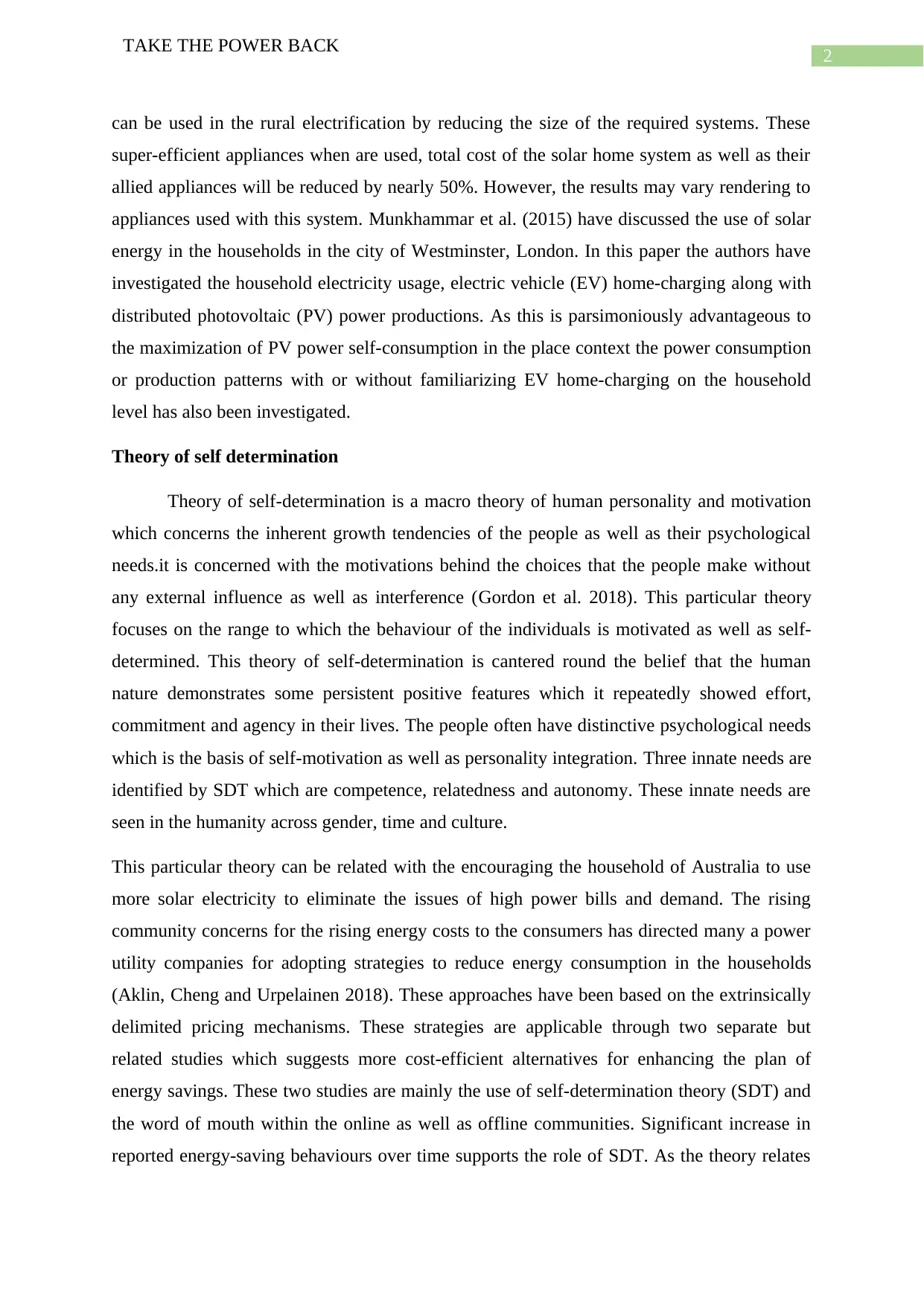
2
TAKE THE POWER BACK
can be used in the rural electrification by reducing the size of the required systems. These
super-efficient appliances when are used, total cost of the solar home system as well as their
allied appliances will be reduced by nearly 50%. However, the results may vary rendering to
appliances used with this system. Munkhammar et al. (2015) have discussed the use of solar
energy in the households in the city of Westminster, London. In this paper the authors have
investigated the household electricity usage, electric vehicle (EV) home-charging along with
distributed photovoltaic (PV) power productions. As this is parsimoniously advantageous to
the maximization of PV power self-consumption in the place context the power consumption
or production patterns with or without familiarizing EV home-charging on the household
level has also been investigated.
Theory of self determination
Theory of self-determination is a macro theory of human personality and motivation
which concerns the inherent growth tendencies of the people as well as their psychological
needs.it is concerned with the motivations behind the choices that the people make without
any external influence as well as interference (Gordon et al. 2018). This particular theory
focuses on the range to which the behaviour of the individuals is motivated as well as self-
determined. This theory of self-determination is cantered round the belief that the human
nature demonstrates some persistent positive features which it repeatedly showed effort,
commitment and agency in their lives. The people often have distinctive psychological needs
which is the basis of self-motivation as well as personality integration. Three innate needs are
identified by SDT which are competence, relatedness and autonomy. These innate needs are
seen in the humanity across gender, time and culture.
This particular theory can be related with the encouraging the household of Australia to use
more solar electricity to eliminate the issues of high power bills and demand. The rising
community concerns for the rising energy costs to the consumers has directed many a power
utility companies for adopting strategies to reduce energy consumption in the households
(Aklin, Cheng and Urpelainen 2018). These approaches have been based on the extrinsically
delimited pricing mechanisms. These strategies are applicable through two separate but
related studies which suggests more cost‐efficient alternatives for enhancing the plan of
energy savings. These two studies are mainly the use of self‐determination theory (SDT) and
the word of mouth within the online as well as offline communities. Significant increase in
reported energy‐saving behaviours over time supports the role of SDT. As the theory relates
TAKE THE POWER BACK
can be used in the rural electrification by reducing the size of the required systems. These
super-efficient appliances when are used, total cost of the solar home system as well as their
allied appliances will be reduced by nearly 50%. However, the results may vary rendering to
appliances used with this system. Munkhammar et al. (2015) have discussed the use of solar
energy in the households in the city of Westminster, London. In this paper the authors have
investigated the household electricity usage, electric vehicle (EV) home-charging along with
distributed photovoltaic (PV) power productions. As this is parsimoniously advantageous to
the maximization of PV power self-consumption in the place context the power consumption
or production patterns with or without familiarizing EV home-charging on the household
level has also been investigated.
Theory of self determination
Theory of self-determination is a macro theory of human personality and motivation
which concerns the inherent growth tendencies of the people as well as their psychological
needs.it is concerned with the motivations behind the choices that the people make without
any external influence as well as interference (Gordon et al. 2018). This particular theory
focuses on the range to which the behaviour of the individuals is motivated as well as self-
determined. This theory of self-determination is cantered round the belief that the human
nature demonstrates some persistent positive features which it repeatedly showed effort,
commitment and agency in their lives. The people often have distinctive psychological needs
which is the basis of self-motivation as well as personality integration. Three innate needs are
identified by SDT which are competence, relatedness and autonomy. These innate needs are
seen in the humanity across gender, time and culture.
This particular theory can be related with the encouraging the household of Australia to use
more solar electricity to eliminate the issues of high power bills and demand. The rising
community concerns for the rising energy costs to the consumers has directed many a power
utility companies for adopting strategies to reduce energy consumption in the households
(Aklin, Cheng and Urpelainen 2018). These approaches have been based on the extrinsically
delimited pricing mechanisms. These strategies are applicable through two separate but
related studies which suggests more cost‐efficient alternatives for enhancing the plan of
energy savings. These two studies are mainly the use of self‐determination theory (SDT) and
the word of mouth within the online as well as offline communities. Significant increase in
reported energy‐saving behaviours over time supports the role of SDT. As the theory relates
⊘ This is a preview!⊘
Do you want full access?
Subscribe today to unlock all pages.

Trusted by 1+ million students worldwide
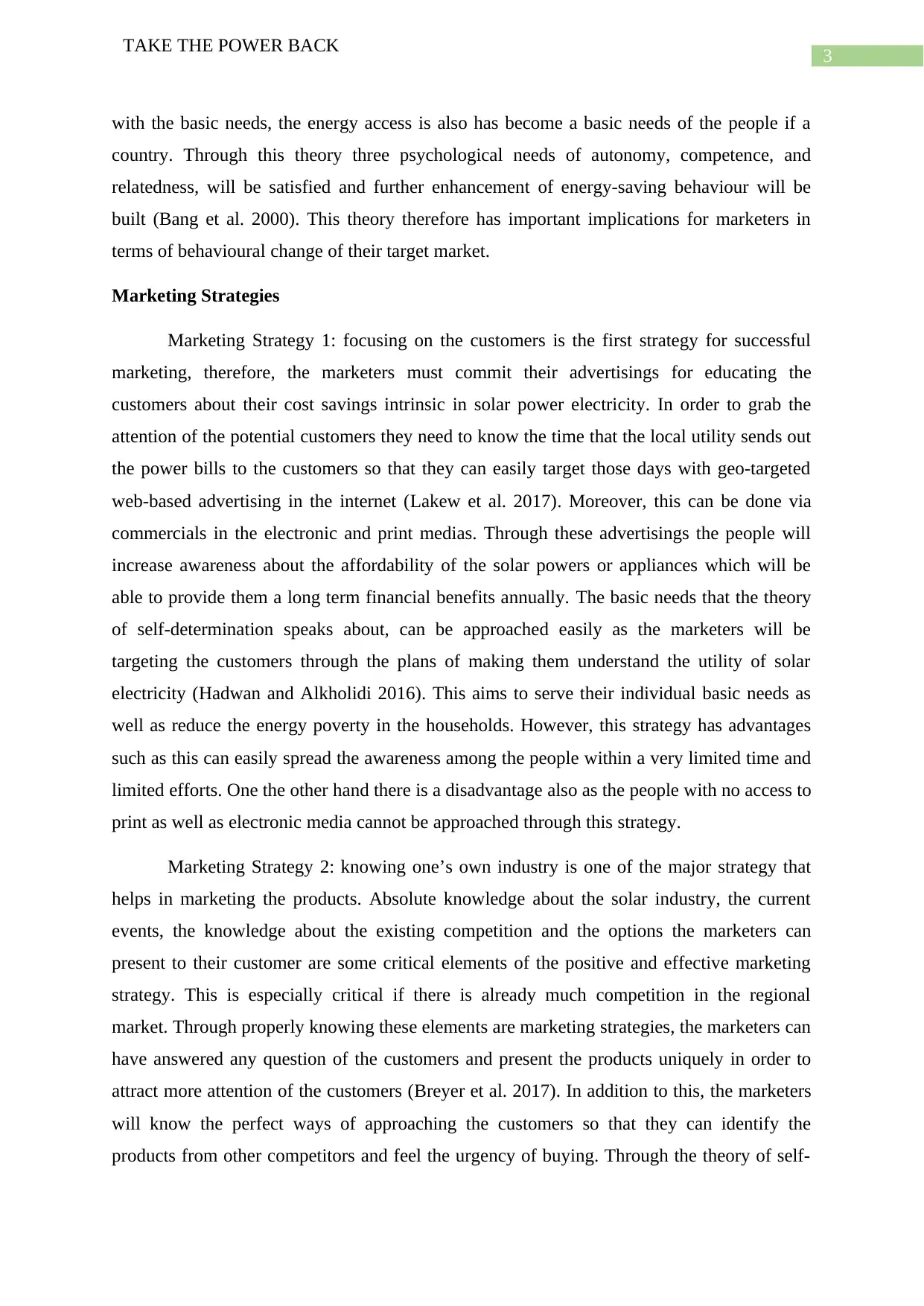
3
TAKE THE POWER BACK
with the basic needs, the energy access is also has become a basic needs of the people if a
country. Through this theory three psychological needs of autonomy, competence, and
relatedness, will be satisfied and further enhancement of energy‐saving behaviour will be
built (Bang et al. 2000). This theory therefore has important implications for marketers in
terms of behavioural change of their target market.
Marketing Strategies
Marketing Strategy 1: focusing on the customers is the first strategy for successful
marketing, therefore, the marketers must commit their advertisings for educating the
customers about their cost savings intrinsic in solar power electricity. In order to grab the
attention of the potential customers they need to know the time that the local utility sends out
the power bills to the customers so that they can easily target those days with geo-targeted
web-based advertising in the internet (Lakew et al. 2017). Moreover, this can be done via
commercials in the electronic and print medias. Through these advertisings the people will
increase awareness about the affordability of the solar powers or appliances which will be
able to provide them a long term financial benefits annually. The basic needs that the theory
of self-determination speaks about, can be approached easily as the marketers will be
targeting the customers through the plans of making them understand the utility of solar
electricity (Hadwan and Alkholidi 2016). This aims to serve their individual basic needs as
well as reduce the energy poverty in the households. However, this strategy has advantages
such as this can easily spread the awareness among the people within a very limited time and
limited efforts. One the other hand there is a disadvantage also as the people with no access to
print as well as electronic media cannot be approached through this strategy.
Marketing Strategy 2: knowing one’s own industry is one of the major strategy that
helps in marketing the products. Absolute knowledge about the solar industry, the current
events, the knowledge about the existing competition and the options the marketers can
present to their customer are some critical elements of the positive and effective marketing
strategy. This is especially critical if there is already much competition in the regional
market. Through properly knowing these elements are marketing strategies, the marketers can
have answered any question of the customers and present the products uniquely in order to
attract more attention of the customers (Breyer et al. 2017). In addition to this, the marketers
will know the perfect ways of approaching the customers so that they can identify the
products from other competitors and feel the urgency of buying. Through the theory of self-
TAKE THE POWER BACK
with the basic needs, the energy access is also has become a basic needs of the people if a
country. Through this theory three psychological needs of autonomy, competence, and
relatedness, will be satisfied and further enhancement of energy‐saving behaviour will be
built (Bang et al. 2000). This theory therefore has important implications for marketers in
terms of behavioural change of their target market.
Marketing Strategies
Marketing Strategy 1: focusing on the customers is the first strategy for successful
marketing, therefore, the marketers must commit their advertisings for educating the
customers about their cost savings intrinsic in solar power electricity. In order to grab the
attention of the potential customers they need to know the time that the local utility sends out
the power bills to the customers so that they can easily target those days with geo-targeted
web-based advertising in the internet (Lakew et al. 2017). Moreover, this can be done via
commercials in the electronic and print medias. Through these advertisings the people will
increase awareness about the affordability of the solar powers or appliances which will be
able to provide them a long term financial benefits annually. The basic needs that the theory
of self-determination speaks about, can be approached easily as the marketers will be
targeting the customers through the plans of making them understand the utility of solar
electricity (Hadwan and Alkholidi 2016). This aims to serve their individual basic needs as
well as reduce the energy poverty in the households. However, this strategy has advantages
such as this can easily spread the awareness among the people within a very limited time and
limited efforts. One the other hand there is a disadvantage also as the people with no access to
print as well as electronic media cannot be approached through this strategy.
Marketing Strategy 2: knowing one’s own industry is one of the major strategy that
helps in marketing the products. Absolute knowledge about the solar industry, the current
events, the knowledge about the existing competition and the options the marketers can
present to their customer are some critical elements of the positive and effective marketing
strategy. This is especially critical if there is already much competition in the regional
market. Through properly knowing these elements are marketing strategies, the marketers can
have answered any question of the customers and present the products uniquely in order to
attract more attention of the customers (Breyer et al. 2017). In addition to this, the marketers
will know the perfect ways of approaching the customers so that they can identify the
products from other competitors and feel the urgency of buying. Through the theory of self-
Paraphrase This Document
Need a fresh take? Get an instant paraphrase of this document with our AI Paraphraser
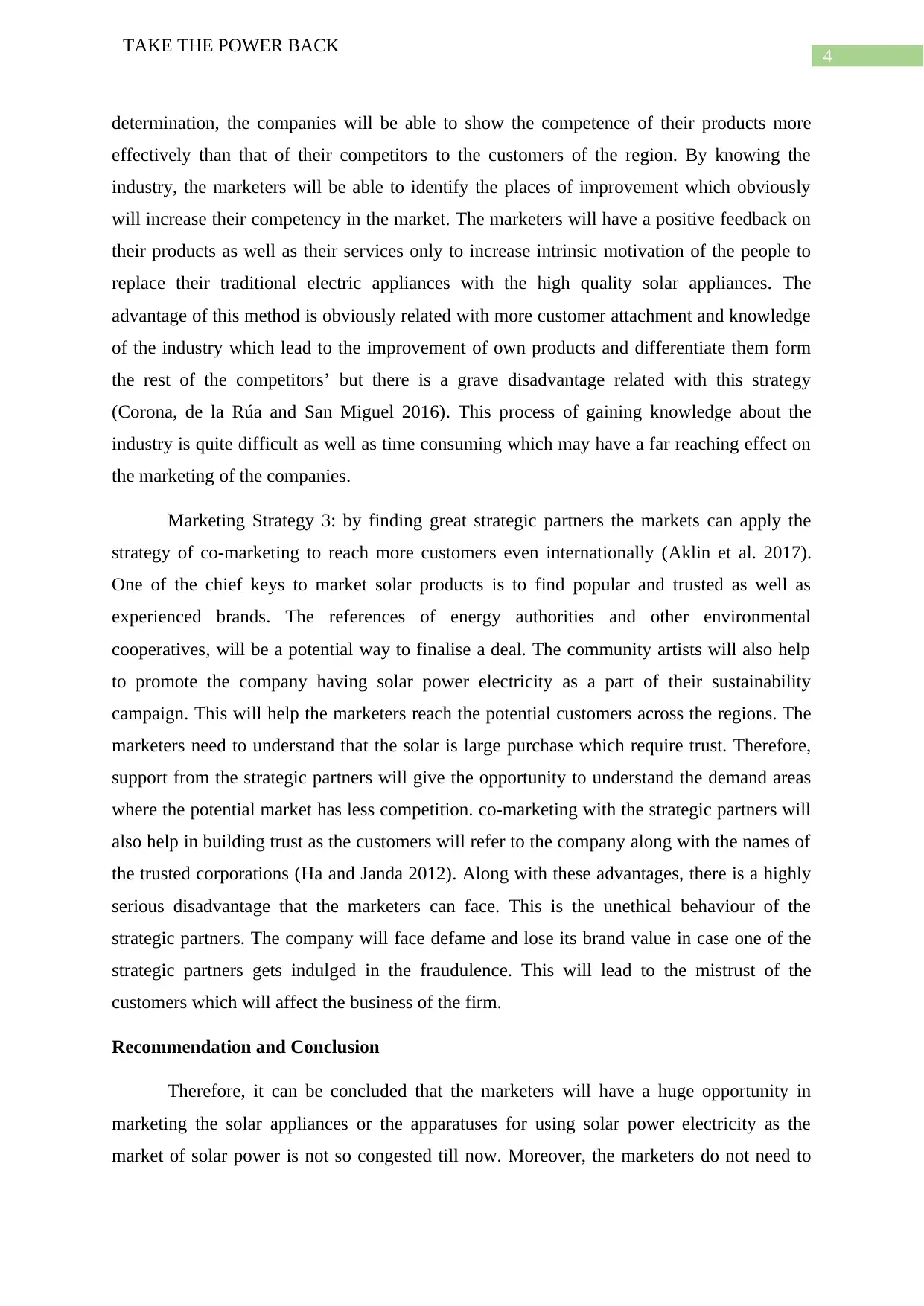
4
TAKE THE POWER BACK
determination, the companies will be able to show the competence of their products more
effectively than that of their competitors to the customers of the region. By knowing the
industry, the marketers will be able to identify the places of improvement which obviously
will increase their competency in the market. The marketers will have a positive feedback on
their products as well as their services only to increase intrinsic motivation of the people to
replace their traditional electric appliances with the high quality solar appliances. The
advantage of this method is obviously related with more customer attachment and knowledge
of the industry which lead to the improvement of own products and differentiate them form
the rest of the competitors’ but there is a grave disadvantage related with this strategy
(Corona, de la Rúa and San Miguel 2016). This process of gaining knowledge about the
industry is quite difficult as well as time consuming which may have a far reaching effect on
the marketing of the companies.
Marketing Strategy 3: by finding great strategic partners the markets can apply the
strategy of co-marketing to reach more customers even internationally (Aklin et al. 2017).
One of the chief keys to market solar products is to find popular and trusted as well as
experienced brands. The references of energy authorities and other environmental
cooperatives, will be a potential way to finalise a deal. The community artists will also help
to promote the company having solar power electricity as a part of their sustainability
campaign. This will help the marketers reach the potential customers across the regions. The
marketers need to understand that the solar is large purchase which require trust. Therefore,
support from the strategic partners will give the opportunity to understand the demand areas
where the potential market has less competition. co-marketing with the strategic partners will
also help in building trust as the customers will refer to the company along with the names of
the trusted corporations (Ha and Janda 2012). Along with these advantages, there is a highly
serious disadvantage that the marketers can face. This is the unethical behaviour of the
strategic partners. The company will face defame and lose its brand value in case one of the
strategic partners gets indulged in the fraudulence. This will lead to the mistrust of the
customers which will affect the business of the firm.
Recommendation and Conclusion
Therefore, it can be concluded that the marketers will have a huge opportunity in
marketing the solar appliances or the apparatuses for using solar power electricity as the
market of solar power is not so congested till now. Moreover, the marketers do not need to
TAKE THE POWER BACK
determination, the companies will be able to show the competence of their products more
effectively than that of their competitors to the customers of the region. By knowing the
industry, the marketers will be able to identify the places of improvement which obviously
will increase their competency in the market. The marketers will have a positive feedback on
their products as well as their services only to increase intrinsic motivation of the people to
replace their traditional electric appliances with the high quality solar appliances. The
advantage of this method is obviously related with more customer attachment and knowledge
of the industry which lead to the improvement of own products and differentiate them form
the rest of the competitors’ but there is a grave disadvantage related with this strategy
(Corona, de la Rúa and San Miguel 2016). This process of gaining knowledge about the
industry is quite difficult as well as time consuming which may have a far reaching effect on
the marketing of the companies.
Marketing Strategy 3: by finding great strategic partners the markets can apply the
strategy of co-marketing to reach more customers even internationally (Aklin et al. 2017).
One of the chief keys to market solar products is to find popular and trusted as well as
experienced brands. The references of energy authorities and other environmental
cooperatives, will be a potential way to finalise a deal. The community artists will also help
to promote the company having solar power electricity as a part of their sustainability
campaign. This will help the marketers reach the potential customers across the regions. The
marketers need to understand that the solar is large purchase which require trust. Therefore,
support from the strategic partners will give the opportunity to understand the demand areas
where the potential market has less competition. co-marketing with the strategic partners will
also help in building trust as the customers will refer to the company along with the names of
the trusted corporations (Ha and Janda 2012). Along with these advantages, there is a highly
serious disadvantage that the marketers can face. This is the unethical behaviour of the
strategic partners. The company will face defame and lose its brand value in case one of the
strategic partners gets indulged in the fraudulence. This will lead to the mistrust of the
customers which will affect the business of the firm.
Recommendation and Conclusion
Therefore, it can be concluded that the marketers will have a huge opportunity in
marketing the solar appliances or the apparatuses for using solar power electricity as the
market of solar power is not so congested till now. Moreover, the marketers do not need to

5
TAKE THE POWER BACK
indulge in creating awareness among the customers as the demand for solar electricity is
already increasing which is expanding the market very fast. However, there are some
strategies which can be followed by the marketers to successfully market their solar products
and increase the demand gradually. Following this, the marketers need to know each and
every side of their business and gain absolute knowledge about their industry so that they can
enhance their potential through constant innovation.
TAKE THE POWER BACK
indulge in creating awareness among the customers as the demand for solar electricity is
already increasing which is expanding the market very fast. However, there are some
strategies which can be followed by the marketers to successfully market their solar products
and increase the demand gradually. Following this, the marketers need to know each and
every side of their business and gain absolute knowledge about their industry so that they can
enhance their potential through constant innovation.
⊘ This is a preview!⊘
Do you want full access?
Subscribe today to unlock all pages.

Trusted by 1+ million students worldwide
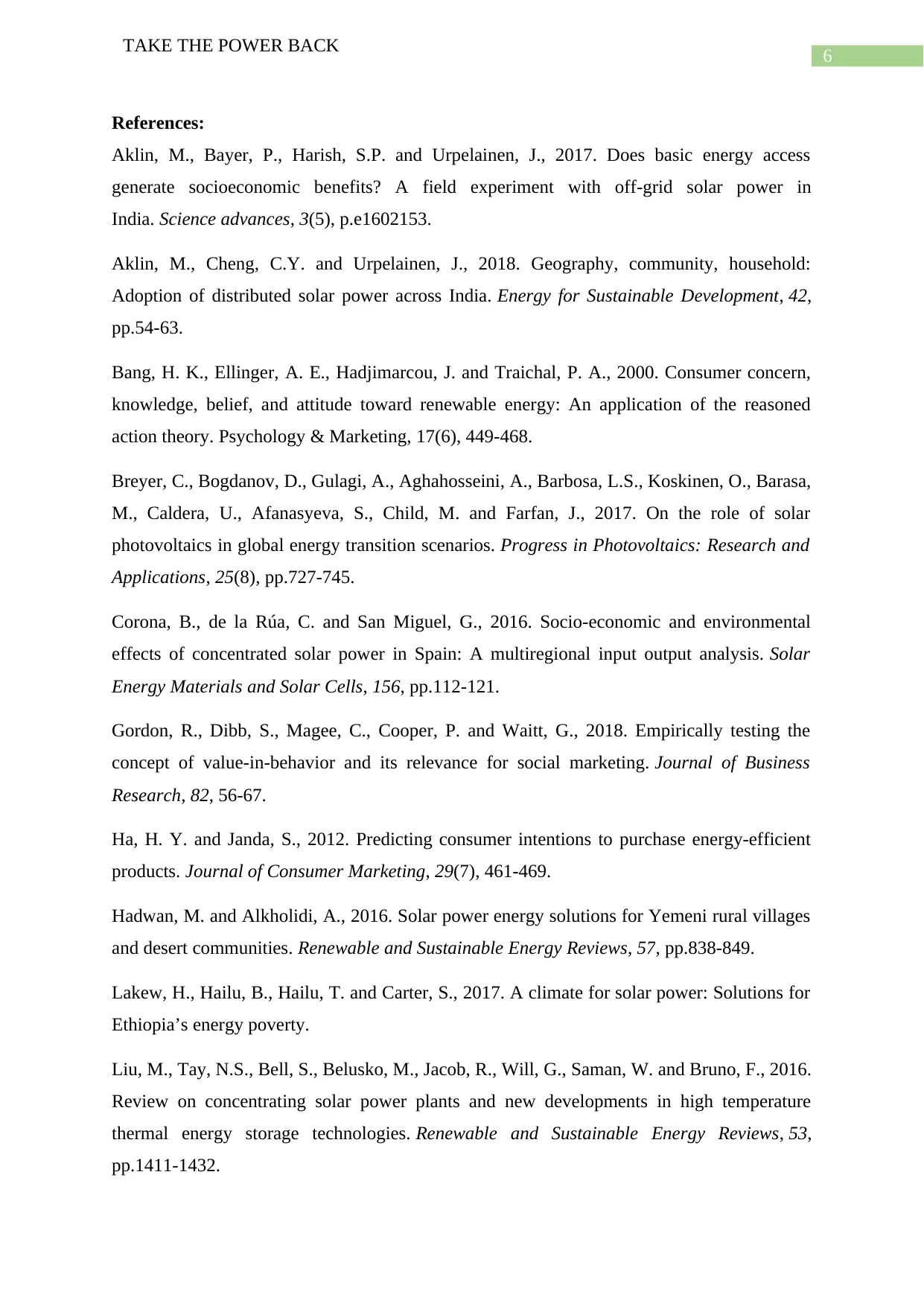
6
TAKE THE POWER BACK
References:
Aklin, M., Bayer, P., Harish, S.P. and Urpelainen, J., 2017. Does basic energy access
generate socioeconomic benefits? A field experiment with off-grid solar power in
India. Science advances, 3(5), p.e1602153.
Aklin, M., Cheng, C.Y. and Urpelainen, J., 2018. Geography, community, household:
Adoption of distributed solar power across India. Energy for Sustainable Development, 42,
pp.54-63.
Bang, H. K., Ellinger, A. E., Hadjimarcou, J. and Traichal, P. A., 2000. Consumer concern,
knowledge, belief, and attitude toward renewable energy: An application of the reasoned
action theory. Psychology & Marketing, 17(6), 449-468.
Breyer, C., Bogdanov, D., Gulagi, A., Aghahosseini, A., Barbosa, L.S., Koskinen, O., Barasa,
M., Caldera, U., Afanasyeva, S., Child, M. and Farfan, J., 2017. On the role of solar
photovoltaics in global energy transition scenarios. Progress in Photovoltaics: Research and
Applications, 25(8), pp.727-745.
Corona, B., de la Rúa, C. and San Miguel, G., 2016. Socio-economic and environmental
effects of concentrated solar power in Spain: A multiregional input output analysis. Solar
Energy Materials and Solar Cells, 156, pp.112-121.
Gordon, R., Dibb, S., Magee, C., Cooper, P. and Waitt, G., 2018. Empirically testing the
concept of value-in-behavior and its relevance for social marketing. Journal of Business
Research, 82, 56-67.
Ha, H. Y. and Janda, S., 2012. Predicting consumer intentions to purchase energy-efficient
products. Journal of Consumer Marketing, 29(7), 461-469.
Hadwan, M. and Alkholidi, A., 2016. Solar power energy solutions for Yemeni rural villages
and desert communities. Renewable and Sustainable Energy Reviews, 57, pp.838-849.
Lakew, H., Hailu, B., Hailu, T. and Carter, S., 2017. A climate for solar power: Solutions for
Ethiopia’s energy poverty.
Liu, M., Tay, N.S., Bell, S., Belusko, M., Jacob, R., Will, G., Saman, W. and Bruno, F., 2016.
Review on concentrating solar power plants and new developments in high temperature
thermal energy storage technologies. Renewable and Sustainable Energy Reviews, 53,
pp.1411-1432.
TAKE THE POWER BACK
References:
Aklin, M., Bayer, P., Harish, S.P. and Urpelainen, J., 2017. Does basic energy access
generate socioeconomic benefits? A field experiment with off-grid solar power in
India. Science advances, 3(5), p.e1602153.
Aklin, M., Cheng, C.Y. and Urpelainen, J., 2018. Geography, community, household:
Adoption of distributed solar power across India. Energy for Sustainable Development, 42,
pp.54-63.
Bang, H. K., Ellinger, A. E., Hadjimarcou, J. and Traichal, P. A., 2000. Consumer concern,
knowledge, belief, and attitude toward renewable energy: An application of the reasoned
action theory. Psychology & Marketing, 17(6), 449-468.
Breyer, C., Bogdanov, D., Gulagi, A., Aghahosseini, A., Barbosa, L.S., Koskinen, O., Barasa,
M., Caldera, U., Afanasyeva, S., Child, M. and Farfan, J., 2017. On the role of solar
photovoltaics in global energy transition scenarios. Progress in Photovoltaics: Research and
Applications, 25(8), pp.727-745.
Corona, B., de la Rúa, C. and San Miguel, G., 2016. Socio-economic and environmental
effects of concentrated solar power in Spain: A multiregional input output analysis. Solar
Energy Materials and Solar Cells, 156, pp.112-121.
Gordon, R., Dibb, S., Magee, C., Cooper, P. and Waitt, G., 2018. Empirically testing the
concept of value-in-behavior and its relevance for social marketing. Journal of Business
Research, 82, 56-67.
Ha, H. Y. and Janda, S., 2012. Predicting consumer intentions to purchase energy-efficient
products. Journal of Consumer Marketing, 29(7), 461-469.
Hadwan, M. and Alkholidi, A., 2016. Solar power energy solutions for Yemeni rural villages
and desert communities. Renewable and Sustainable Energy Reviews, 57, pp.838-849.
Lakew, H., Hailu, B., Hailu, T. and Carter, S., 2017. A climate for solar power: Solutions for
Ethiopia’s energy poverty.
Liu, M., Tay, N.S., Bell, S., Belusko, M., Jacob, R., Will, G., Saman, W. and Bruno, F., 2016.
Review on concentrating solar power plants and new developments in high temperature
thermal energy storage technologies. Renewable and Sustainable Energy Reviews, 53,
pp.1411-1432.
Paraphrase This Document
Need a fresh take? Get an instant paraphrase of this document with our AI Paraphraser

7
TAKE THE POWER BACK
Munkhammar, J., Bishop, J.D., Sarralde, J.J., Tian, W. and Choudhary, R., 2015. Household
electricity use, electric vehicle home-charging and distributed photovoltaic power production
in the city of Westminster. Energy and Buildings, 86, pp.439-448.
Phadke, A.A., Jacobson, A., Park, W.Y., Lee, G.R., Alstone, P. and Khare, A., 2017.
Powering a home with just 25 Watts of solar PV: super-efficient appliances can enable
expanded off-grid energy service using small solar power systems.
TAKE THE POWER BACK
Munkhammar, J., Bishop, J.D., Sarralde, J.J., Tian, W. and Choudhary, R., 2015. Household
electricity use, electric vehicle home-charging and distributed photovoltaic power production
in the city of Westminster. Energy and Buildings, 86, pp.439-448.
Phadke, A.A., Jacobson, A., Park, W.Y., Lee, G.R., Alstone, P. and Khare, A., 2017.
Powering a home with just 25 Watts of solar PV: super-efficient appliances can enable
expanded off-grid energy service using small solar power systems.
1 out of 8
Related Documents
Your All-in-One AI-Powered Toolkit for Academic Success.
+13062052269
info@desklib.com
Available 24*7 on WhatsApp / Email
![[object Object]](/_next/static/media/star-bottom.7253800d.svg)
Unlock your academic potential
Copyright © 2020–2025 A2Z Services. All Rights Reserved. Developed and managed by ZUCOL.




